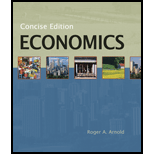Sorry! We don’t have solutions for this edition yet.
Solutions are available for other editions of this book
View 12th Edition solutionsarrow_forwardView 13th Edition solutionsarrow_forwardBook Details
Roger Arnold's ESSENTIALS OF ECONOMICS distills the core concepts of economics into a concise text that is reader-friendly, yet still complete in its coverage of topics. With a focus on real world examples and applications, Arnold conveys the impact of economic analysis on everyday life, insightfully explaining the economics of why Lebron James isn't in college, drug busts, and how spring break affects surrounding communities. Taking a more concise approach than some traditional principles of Economics texts, ESSENTIALS OF ECONOMICS continues to provide solid coverage of macroeconomic and microeconomic fundamentals. Thorough coverage of AD/AS, money & banking and monetary and fiscal policy, expectations theory, market structures and market failures gives students all the background necessary to either continue their studies in economics, or simply gain a new perspective on events around the world and in their lives through the versatile lens of economics.
Benefits:
- NEW! Aplia Integration: The content of the Arnold Concise 1st edition has been fully integrated with Aplia. Students and instructors will benefit from strong learning elements of Aplia tied directly to the language and exercises in Arnold's text.
- Thorough coverage of market structures and policies including perfect competition, monopoly, and monopolistic competition and oligopoly.
- "Economics In...Popular Culture, The World, Technology, and Everyday Life" boxes highlight the ways that economics and economic analysis is at work in the real world, every day. From blogging to getting to class on time to economics in the Wizard of Oz, the Economics In features drive home the value of economic analysis to everyone, every day.
- "A Reader Asks" end of chapter feature asks the kinds of questions that students regularly pose, such as, "What's in store for an Economics Major?" "How Will Economics Help Me if I'm a History Major?" or "Do Colleges and Universities Price Discriminate?" These questions and answers reinforce the relevance of Arnold's approach to economics with readers and helps motivate them in the "economic" way of thinking.
- "A Closer Look" exhibits takes the reader step by step through key diagrams to better support understanding of the concept under examination. These detailed exhibits show detail with thorough explanation of each step to ensure that readers follow the entire diagram from start to finish.
- Self-Tests throughout each chapter help students evaluate their understanding of chapter material as they go along, so that complex or challenging topics can be reviewed as needed.
- Thinking Like an Economist features demonstrate the economist's way of thinking through various scenarios such as "Is self-interest the same as greed?" or whether individuals with a high income will tend to buy higher-priced cars. Thinking Like an Economist helps students to develop their economics "lens" through which they can then view many different aspects of the world around them.
- Comprehensive End-of-Chapter pedagogy including Chapter summaries, Key Terms and Concepts, Questions & Problems, Working with Numbers and Graph, and Internet Activities.
- Comprehensive supplemental package including Instructor's Manual, Test Bank, Examview Testing software, Instructor's Resource CD-Rom, Study Guide, and PowerPoint presentation slides.
- NEW! Concise, Streamlined Content: The concise, easily relatable coverage and a solid theoretical foundation for principles allows students and instructors to emphasize the key economics topics in only 24 chapters.
- NEW! Student Focused Macroeconomics Coverage: The Concise edition features three "Major Questions in Macroeconomics" and "Three Macro Organization Categories" to introduce learners to the basic ideas in macroeconomics, and how these issues relate to their lives, right away.
- NEW! Engaging Student Pedagogy: Proven features that engage student interest and relate economics to the world as they see it: Economics in Popular Culture, Everyday Life, The World, and Technology.
- NEW! "A Reader Asks": This text feature highlights discussion questions students might ask their instructors, if they were not constrained by time or large class sizes.
- NEW! "Thinking Like an Economist": This pedagogical element helps learners develop the "economic way of thinking" in brief, digestible margin features. This element helps students relate the text material with their every day lives.
- Concise and complete coverage of all core economics concepts in 24 chapters, including international trade and finance provides broad coverage and understanding of all the key topics in less time.
- Setting the Scene and Analyzing the Scene features. Setting the Scene introduces a scenario out of everyday life and then asks readers to consider the economics implications as they read through the chapter. Analyzing the Scene appears throughout the chapters as the concepts answer or provide analysis for the questions posed in Setting the Scene. Analyzing the Scene helps students place in context the scenario describing in the opening Setting the Scene.
- Streamlined, topical and concise coverage of important (and sometimes challenging) macroeconomics concepts of money & banking, monetary, and fiscal policy.
More Editions of This Book
Corresponding editions of this textbook are also available below:
